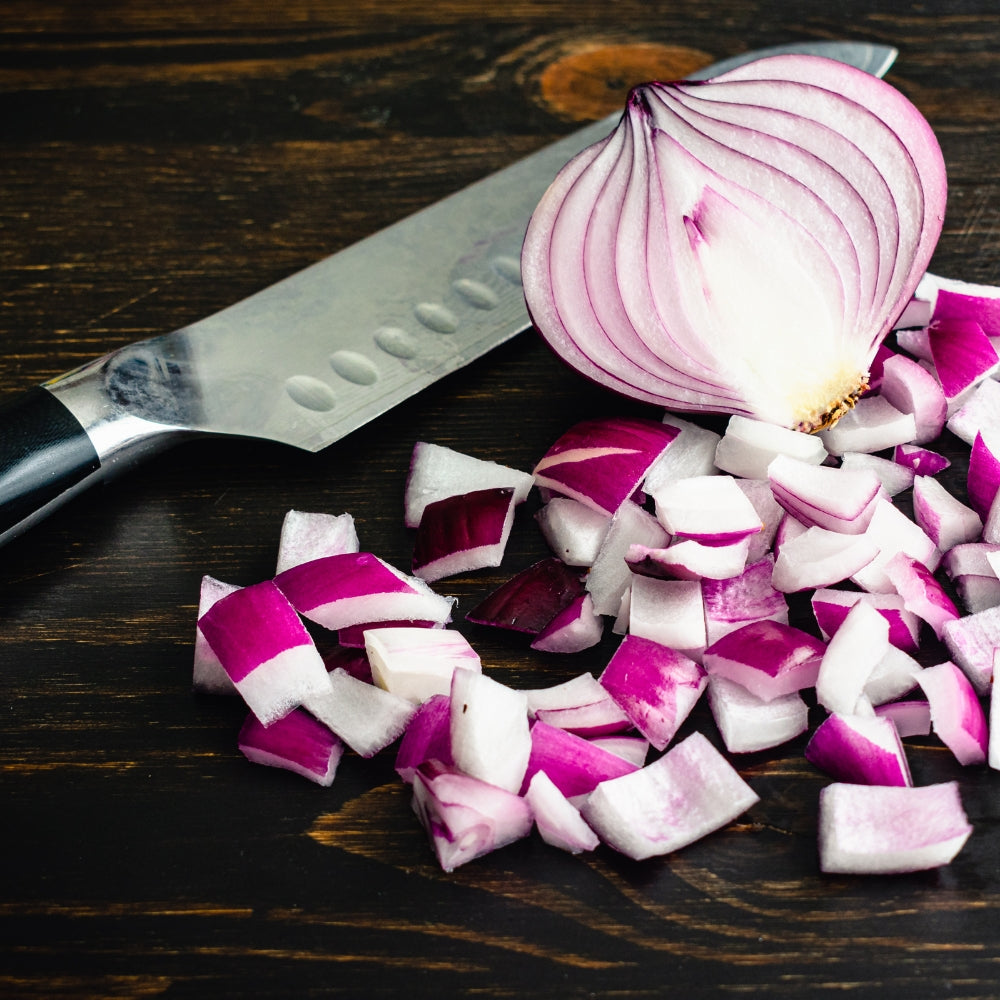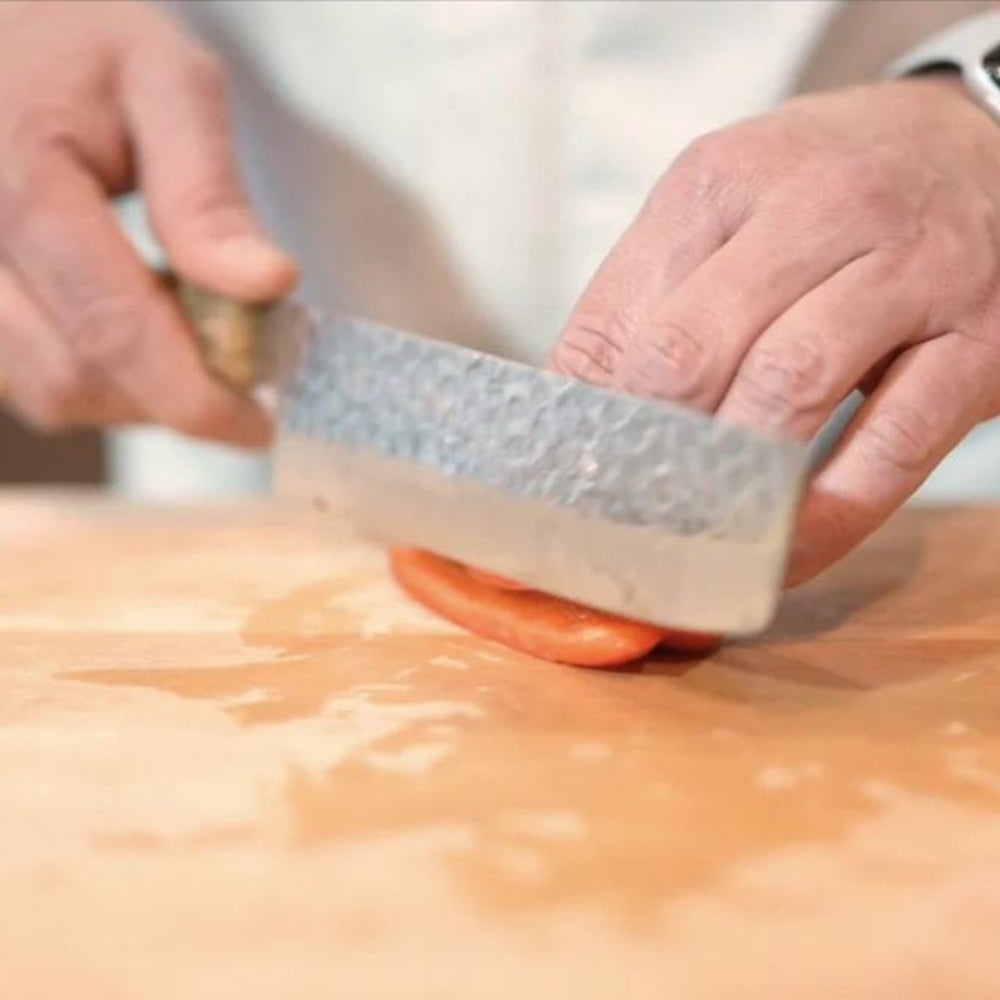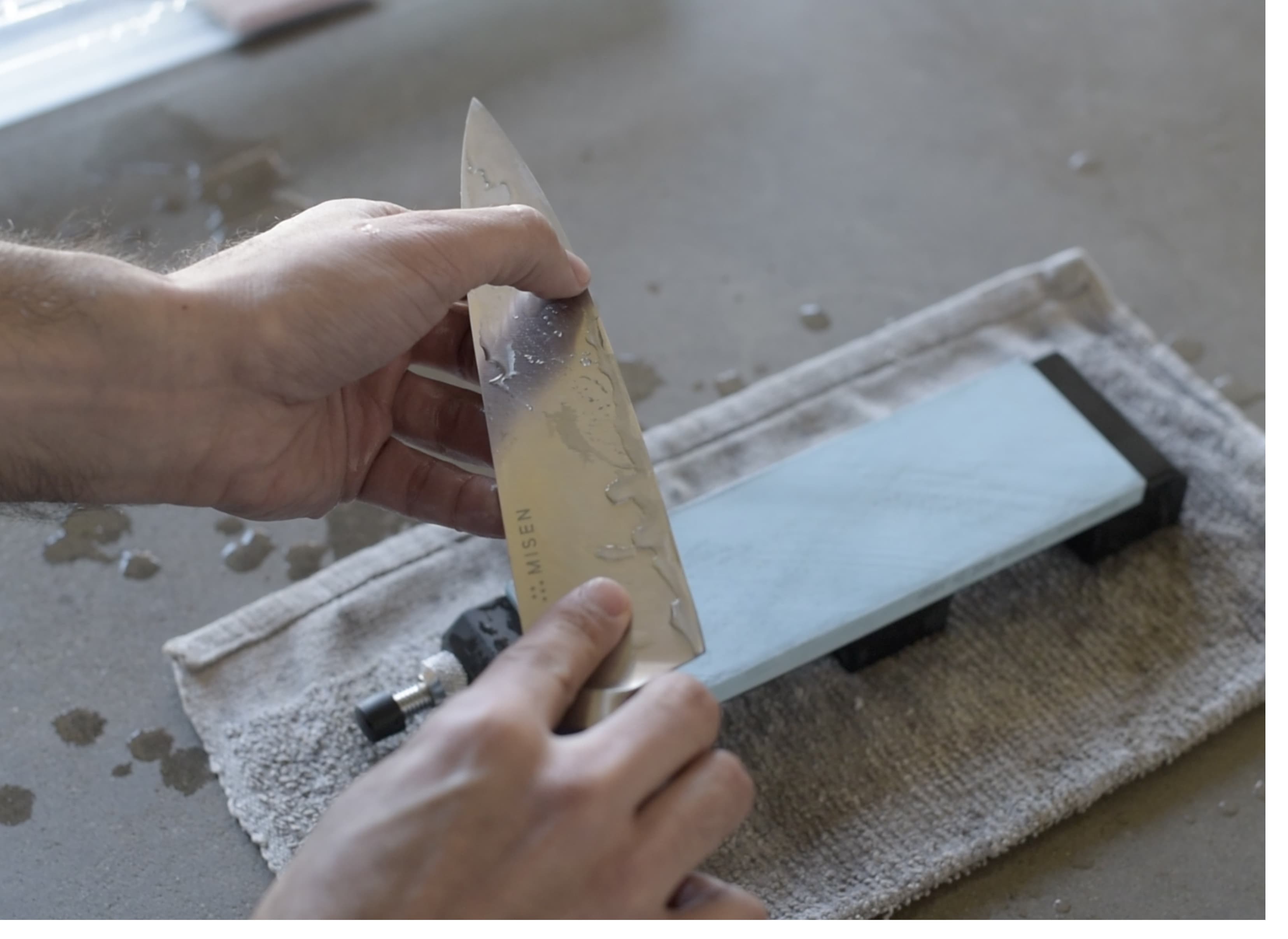
Understanding the Santoku Knife: What Does It Do?
By Kenny Trusnik
Senior Food Writer at Pro Home Cooks
Ever found yourself standing in the kitchen, puzzled by a peculiar knife that doesn't quite resemble your regular chef's knife? It's shorter, lighter and seems to be crafted with precision. Well, let me introduce you to the multifaceted world of what does a santoku knife do.
This Japanese culinary marvel is like an artist’s brush in your hands – it opens up new possibilities for creating masterpiece meals at home. A secret weapon many professional chefs won’t part with!
You're about to discover how this versatile tool differs from other knives, its key features, unique cutting techniques it empowers and even how best to maintain it. Are you ready?
Ready to elevate your culinary game? Check out our picks of Japanese knives today!
Table Of Contents:
- Understanding the Multifaceted Santoku Knife
- Versatile Cutting Tasks with a Santoku KnifeMastering Different Cutting Techniques
- Creating Fine Slices for Garnishes
- Features and Maintenance of Your Santoku KnifeImportance of Blade Shape and Length
- Caring for Your Santoku Knife
- Comparing the Santoku Knife and Chef's KnifeAnalyzing Blade Material
- Choosing Between a Santuko or Chef’s Knife
- Expert Reviews on Top-Rated Santuko KnivesDiving into User Testimonials
- Finding The Best For Your Budget
- Evaluating Performance Ratings
- FAQs in Relation to What Does a Santoku Knife Do
- Conclusion
Understanding the Multifaceted Santoku Knife
The Santoku knife, a versatile tool in any kitchen, originated from Japan. Its particular qualities make it stand out from other all-purpose knives. Let's take an enlightening journey through its traditional Japanese origins and key features.
Santoku knives boast a wide sheepsfoot blade with no tip. This distinctive shape makes them ideal for precision cutting tasks such as slicing vegetables or dicing meats. The design of this blade takes inspiration from the humble sheep's foot – hence its name.
One remarkable feature is their construction material: thinner, harder steel compared to western-style blades. Lighter weight with balanced handling are added perks that come along due to this difference in build materials. However, don't let the lighter feel fool you; these knives are known for their durability and longevity if properly maintained.
If you're new to home cooking or looking to expand your culinary toolkit beyond basic chef’s knives, introducing yourself to the multifaceted world of santoku might just be what you need. So why wait? Grab one today.
Versatile Cutting Tasks with a Santoku Knife
The Santoku knife is your go-to kitchen companion when it comes to various cutting tasks. The Santoku knife's special shape makes it simple to cut, dice and mince food.
Mastering Different Cutting Techniques
Akin to a symphony conductor directing the orchestra, mastering different cutting techniques lets you orchestrate culinary masterpieces in your kitchen. A well-sharpened santoku knife enables precise cuts which are integral for creating those visually stunning dishes we all love.
You might wonder how this one tool can be so versatile. It's all about the thin blade - thinner than most knives used in Western cooking. This gives you better control over the thickness of each slice or dice while also reducing food sticking onto the blade during use.
Creating Fine Slices for Garnishes
Surely everyone has watched chefs on TV artfully garnishing their plates and wished they could replicate that finesse at home? Here’s where precision cutting with a santoku knife comes into play.
Fine slices aren't just about aesthetics; they can actually change how flavors meld together within a dish because of their increased surface area compared to chunkier pieces. Serious Eats delves more into this topic if you're interested.
In conclusion, we’ve seen why Santokus are best used for chopping, dicing, and mincing due to their thin blades; but remember that practice makes perfect. Whether it’s chopping meat or slicing cheese, the Santoku knife is your ally in creating memorable meals. So let's get slicing with a santoku knife and start dicing fruits and vegetables using this remarkable tool.
Features and Maintenance of Your Santoku Knife
The key to becoming a pro in the kitchen is understanding your tools. One such essential tool, the Santoku knife, has unique features that set it apart.
Importance of Blade Shape and Length
The Santoku knife boasts a blade shape like no other - with a straight edge and granton indentations. These are not just for show; they play crucial roles in precision cutting tasks.
The flat, straight edge gives you better contact with the chopping board compared to curved blades. This means each slice can be done swiftly, without needing that rocking motion common with chef's knives.
If you're asking 'What does 'granton' mean?', well these small scallops along the blade create air pockets while slicing through food items. It helps make sure whatever you're chopping doesn't stick to your knife.
Caring for Your Santoku Knife
A sharp santuko knife makes meal prep enjoyable but maintaining this sharpness needs proper care practices too. And yes, caring goes beyond cleaning after use; let's delve into some details here:
Firstly, storage matters as much as usage. Avoid tossing your beloved santoko among other utensils; get them their own space or even better - invest in a magnetic strip or dedicated drawer block.
Kamikoto 7-inch Santuko Knife deserves special attention because it serves many purposes efficiently if maintained well.
Remember, cleaning is key but avoid dishwashers. Hand-washing your knife with warm soapy water right after use helps preserve its sharpness and longevity. Also, keep it dry to prevent rusting; pat drying does the trick.
Last but not least, regular sharpening keeps that blade in top form. You can easily learn sharpening techniques online for a start.
The magic of a Santuko lies in how you care for it - once you get this right, there's no looking back on your culinary journey.
Get ready to unleash your cooking skills with a Santoku knife, famous for its special blade design and granton grooves. These elements let you breeze through detailed cutting jobs. But don't forget, keeping this all-around tool sharp is equally crucial - storing it correctly, washing by hand after each use, drying thoroughly to prevent rusting and sharpening regularly will make sure it remains in prime condition.
Comparing the Santoku Knife and Chef's Knife
Discover the magic of Japanese culinary tools as we explore what a santoku knife does, its unique features, and how it elevates your home cooking experience.
Analyzing Blade Material
Examine how the materials used in constructing these two types of knives affect their performance.
Chef’s knives typically sport blades that are long, heavy, and robust—usually ranging from 6” to 12”. This weight allows for swift chopping motion while maintaining control. They're like samurais of your kitchen counter. On the other hand, santokus usually have shorter blades with thinner steel which gives them an agile advantage in precision tasks.
The differences between these types aren't just superficial—they greatly affect performance. So before you go on buying any random blade at stores or online sites like 25cm Sabatier Cooks Knife or 20cm Wusthof Classic Cooks Knife, remember that it is important to consider what suits your cooking style best.
Choosing Between a Santuko or Chef’s Knife
Consider factors like personal preference, type of food preparation involved, and hand size when deciding which type of knife is best for you.
If I were to use an analogy here, choosing between these two is much akin to picking Batman over Superman—it boils down mostly to personal preference (and perhaps how much kryptonite you've got stocked up). While versatility may tip towards a chef's knife due to its heftier build suitable for heavier cutting jobs such as disjointing bones; santokus hold their ground with more precise cuts ideal for delicate foods like sushi-grade fish.
But it's not all about the food you're prepping, even hand size matters. Those with smaller hands may find a santoku knife more comfortable and manageable to use because of its lighter weight balance.
In the end, both knives have their merits—it's up to you to decide which one is your culinary sidekick.
Unleash the power of Japanese culinary tools with a santoku knife, designed for precision tasks. Its unique features enhance your home cooking experience. The choice between a chef's knife and a santoku often comes down to personal preference, food preparation style, and hand size - making each tool equally valuable in its own right.
Expert Reviews on Top-Rated Santuko Knives
The realm of kitchen cutlery is filled with a variety of knives, each claiming to be the best at their specific tasks. But let's take a closer look at one that stands out among the rest - the versatile and high-performing Santoku knife.
Rave reviews have been pouring in from both professional chefs and amateur cooks for the balance, sharpness, and versatility of Santoku knives. Whether you're preparing a gourmet meal or just chopping veggies for dinner, these popular knives are worth considering.
Diving into User Testimonials
A key source of insight when choosing your next culinary tool comes from user testimonials. Users love how easy it is to handle Santoku knives because they’re lighter than most chef’s knives while offering similar cutting capabilities. Their compact size also makes them an excellent choice for those with smaller hands or limited counter space.
It's not uncommon to see phrases like 'changed my cooking game' or 'best investment in my kitchen' sprinkled throughout reviews of popular Santoku knives. And we must admit; this feedback certainly adds weight to our appreciation for these multi-purpose tools.
Finding The Best For Your Budget
But let's face it – not all blades are created equal. If you're looking to save money but still want superior performance, there are plenty of economical choices available.
You might find yourself drawn towards something like the 13 cm Kasumi Santoku Knife which offers outstanding value without compromising quality. (source)
Evaluating Performance Ratings
It's also worth looking at performance ratings when choosing a Santoku knife. High-quality blades are made of durable materials that stay sharp for longer, reducing the frequency and cost of sharpening.
Remember: A high-performing knife is an investment in your culinary journey. So take some time to research before you buy.
Santoku knives stand out in the culinary world for their versatility, balance, and sharpness. User testimonials rave about their light weight and compact size that makes handling easy even with smaller hands or limited counter space. Despite budget constraints, quality Santoku knives are accessible - a valuable investment for your cooking endeavors.
FAQs in Relation to What Does a Santoku Knife Do
What foods is a santoku knife used for?
Santoku knives excel at slicing, dicing, and mincing veggies, meats or fish. They're perfect for precise cuts on delicate items like sushi.
How do you use a santoku knife?
To use a Santoku knife effectively, hold it in one hand while guiding the food with the other. Use an up-and-down motion to slice through your ingredients.
Should I use a chef knife or a Santoku?
The choice between Chef's and Santoku knives depends on personal preference. Choose based on comfortability during handling and specific cooking tasks needed.
Is A santoku knife necessary?
A Santoku isn't mandatory but adds versatility to your kitchen toolkit due its proficiency in varied cutting techniques - making food prep easier.
Conclusion
Mastering the art of cooking isn't a piece of cake, but knowing what does a santoku knife do certainly helps.
This Japanese marvel lets you tackle versatile cutting tasks with ease. It's perfect for slicing, dicing, and mincing, not to mention creating fine garnishes that elevate your dishes from good to great.
Maintaining this tool is crucial too. From understanding blade shape and length to learning proper storage practices - it all adds up in ensuring your knife stays sharp and efficient.
The choice between Santoku or Chef’s Knife may boil down to personal preference or specific food prep needs. So explore both options before deciding which suits you best!
Above all, keep practicing because perfection comes over time!
Transform your kitchen experience with the best tools handpicked by Mike. Don't miss out on these essentials. Check out our top selections now!
TOP ARTICLES

Sourdough Baking School
Master the art of sourdough bread baking in the most comprehensive baking class on the internet. This class features over three hours of baking content to help you start your sourdough journey.
See More



